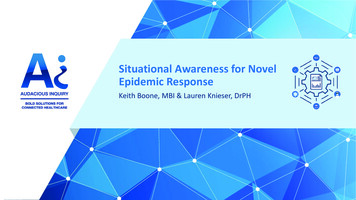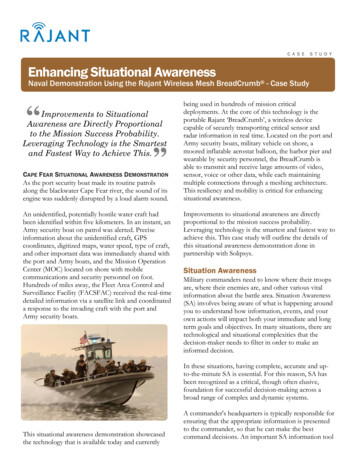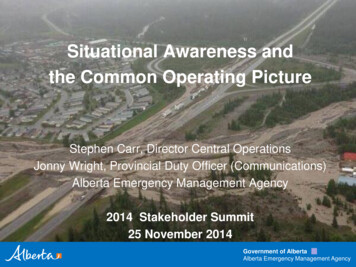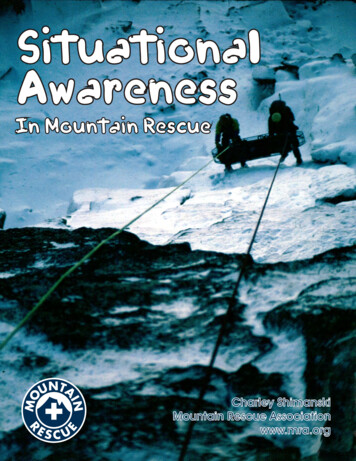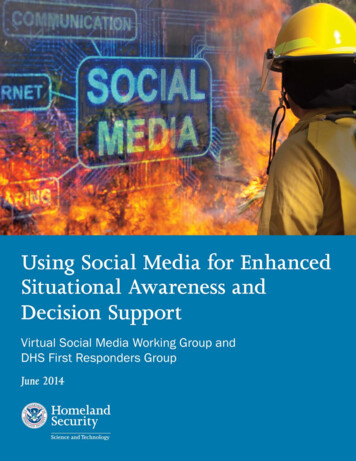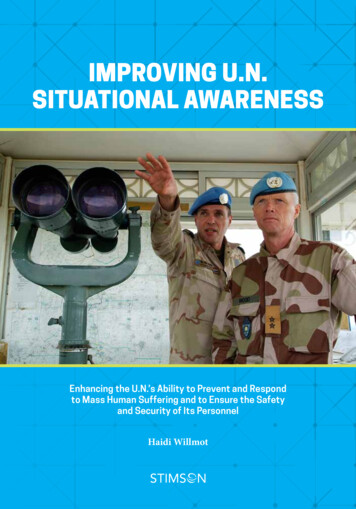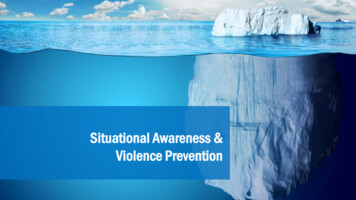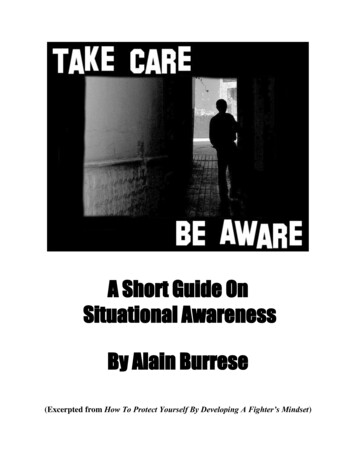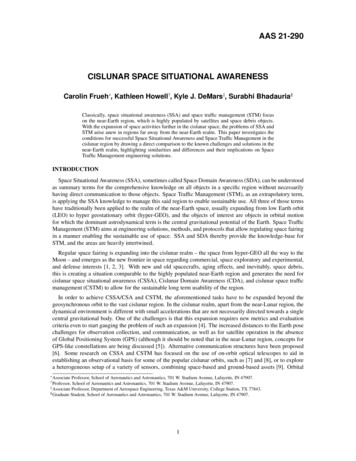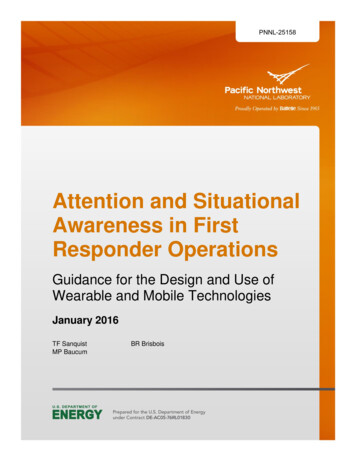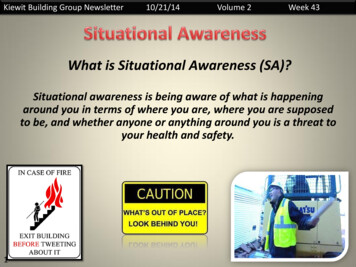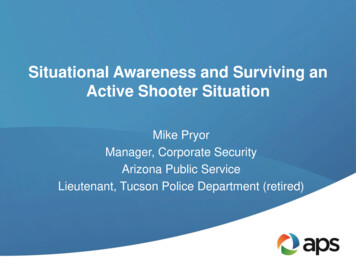
Transcription
Situational Awareness and Surviving anActive Shooter SituationMike PryorManager, Corporate SecurityArizona Public ServiceLieutenant, Tucson Police Department (retired)
Session Objectives Explore active shooter situations and their outcomes Discuss “Situational Awareness” and how to Apply the concept in your everyday life Recognize the challenges of maintaining situational awareness Identify responses to active violence situations Understand “Cover vs. Concealment” Review basic survival techniques in active violence situations
What is an Active Shooter? Definition accepted by U.S. government agencies:“An individual actively engaged in killing or attemptingto kill people in a confined and populated area.” No pattern or method in selection of victims Usually use firearms
2000-2017:250 Active Shooter EventsSource: FBI Quick LookReport
Areas of Risk: Could it Happen to You?Source: FBI Quick LookReport
Total Casualties: 2,217Source: FBI Quick LookReport
Casualties Continue to IncreaseSource: FBI Quick LookReport
Events Continue to IncreaseSource: FBI Quick LookReport
FBI’s Study of Active Shooter Incidents:2000 - 2013Of 160 events studied: 60% ended before police arrived 98% of the shooters acted alone 40% committed suicide 80% used a long gun (rifle,shotgun or carbine) 75% brought multiple weaponsand large amounts of ammunition 13% ended when unarmedcitizens restrained the shooter
Attacks are Dynamic EventsAverage response time to priority 1 calls in Fort Worth is 9 minutes, 27 seconds
Active Shooters are Evolving Trapping victims (Sandy Hook)Pulling fire alarms to flush victims from rooms (Parkland)Proactive planning to increase body count (Parkland / Las Vegas)Multiple firearms and explosives (San Bernardino)Planned fields of fire and high rate of fire weapons (Las Vegas /Pulse) Multiple attackers (Paris) Edged weapons Use of vehicles
What can you do to increase yourchances of survival?SituationalAwareness
Situational Awareness Knowing what is happening around you AND what it means Awareness gives you time to think and react Observe– See and hear what is happening around you Orient– Baselines and anomalies for a particular environment– Mental models of human behavior– Plans of action depending on your observations Observe Orient Situational Awareness
What Puts Us at Risk?Denial Believing it can’t happen––––Those people are not hereIt won’t happen hereIt won’t happen to meIf it does happen, I won’t get hurt Dangerous phrases– What are the odds?– I hope .– With all these people here?
What Puts Us at Risk?Distractions Not paying attention is deadly– This isn’t walking and chewing gum– We engage in activities that move our focus from what isgoing on around us
Practicing Situational Awareness People watchThink like a bad guyUse your sensesUse the environment to your advantage– Reflections in windows– Where are you at in relation to blind corners Be aware of what’s in your hands Think about how you could react Act when appropriate
Practicing Situational Awareness In Public––––––Be aware of where you are and where danger may beUse your senses, especially the Spidey oneStop and assessRecognize and eliminate distractionsBe aware of your appearanceRecognize escape routes At Work–––––Be aware of co-workers and customersKnow the building layoutLook for things out of placeDon’t put yourself in risky situationsBe aware of high risk people and issues In General– Don’t compromise yourself
Through Situational Awareness Reduce your appeal as a victim Give yourself and others time andspace Avoid being in the “black” Practice professional and personalsafety
Increase Your Chance of Survival:Dealing with Active Violence
Dealing with Active Violence Violence can happen anywhere, anytime, for any reason No single course of action will guarantee survival Survival depends on:–––––Situational awarenessHaving a planDecisive actionsBeing willing to fightRefusal to give up
Survival Mindset You cannot decide in the heat of the incident You have choices– Run– Hide– Fight You must always be ready to fight– Decide what you will do to survive
Run if You Can Get to Safety Usually best option unless shooter is– Elevated– Between you and the exit Can you run to safety?––––Are you physically capable of running?Where are you in relationship to exits?Do you know where the shooter is?Where are shots coming from? Run fast, stay low Take cover once outside
Run: Special Situations High rise buildings– Where can you run to?– Stairwells can be dangerous Fall situations Contained target– Elevators can be a very poor choice Crowded venues– Stampede potential
Cover vs. Concealment “Cover” stops bullets “Concealment” prevents you from being targeted– Not ballistic protection Either can save your life Hiding is concealment– Can become cover
Can’t Run? Consider Hiding Pros– Active shooters want instant gratification Won’t waste time or ammo shooting at walls– If they cannot see you, they cannot target you– It can give you time to get ready to fight– You can set the stage for the fight if it comes Cons––––You may have trapped yourselfYou may not be well hiddenThe shooter may have seen youYou may not have cover
Hiding A good course of action if:– You don’t have a clear way to exit– Your exit route would take you closer to the shooter Identify a place to get out of sight of the shooterBe quiet, turn ringers on cell phones offSecure/barricade to delay entryPrepare to fight
Case Comparison: Sandy HookClassroom 1Classroom 2
Lockdown Rooms Any room capable of being locked or barricaded toprevent or delay an attacker from gaining access The best lockdown rooms are:– Pre-identified with a– Have a lockable door– Have no windows A lockdown room is concealment, not cover– Harden the room– Prepare to fight
Barricading Almost any room can conceal– Lock the door if you can– Barricade the door– Use whatever is available– Do what you can to delay entry– Do not peek out
How APS Has IdentifiedLockdown Rooms Should be on every floor Doors have locks installedand no windows Protective laminate on anywindows to delay entry Marked on emergencyevacuation maps Marked with a green dot onthe room
Get to a Lockdown Room Quickly Have you decided to live? Identify rooms to lockdown ahead of time– Make it a topic in safety briefs and staff meetings Stay unseen by the shooter– If you’re seen going in a room, you can be trapped there If you cannot hide, you must run, fight or both
Fight Whether run or hide, be ready to fight Lockdown rooms buy you time to prepare to fight This is a life or death situation Will to win will help you survive Fight to win!
Fighting: Some Basics Shooter reloading is a moment of opportunity Control the muzzle of the weapon Attack from angles or from behind Use a simultaneous attack Force the assailant from offense mode to defense mode Use distraction techniques Fight until the shooter is unable to continue
Boyd’s OODA Loop
Fighting: Your Advantage Numbers Unorthodox strategies Your will to live Ability to planHow hard would you fight to go home?
The Element of Surprise Can’t see whole room from door To get in, attacker must go Attack from a concealed position
Use LeverageControl the Muzzle
When Police Arrive First priority is the threat– They will pass over injured persons Stay where you are– They will tell you when to come out Keep your hands empty and visible at all times Follow directions– You will be detained– You will be interviewed
Being Ready Assess your area– How are you vulnerable?– Where can people hide?– Where can people run to? Employee awareness––––Do you have situational awareness training?Do you talk about dealing with active shooter?Do people know where to run?Do people know where to hide? Threat assessment protocol– Do you have a way to report potential threats?
Recovering From an Event Where will you work from?– Reoccupation can take many weeks How will you maintain operations?– Traumatized workforce– People who cannot go back to the workplace How will you support employees?– Mental and physical health How will you handle with memorials?– Services– Monuments How will you manage with the media?– Speculation– Blame
Final Thoughts It is not “IF” but “WHEN” Awareness matters You CAN survive You can drive change How you prepare makes a difference
Thank You!Mike PryorManager, Corporate SecurityArizona Public ServiceLieutenant, Tucson Police Department (retired)
Situational Awareness Knowing what is happening around you AND what it means Awareness gives you time to think and react Observe – See and hear what is happening around you Orient – Baselines and anomalies for a particular environment – Mental models of human
